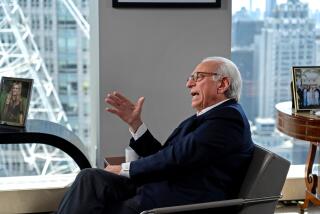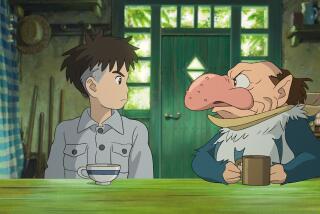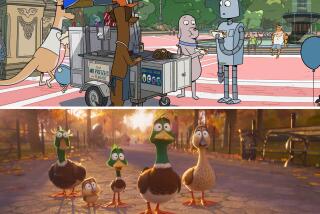The Strongmen Behind ‘Hercules’
By any conventional measure, they are two of the most successful directors in Hollywood, a place that worships success and treats any director who can attain it as gods.
“But we’re benevolent gods,” says the short pale one, pushing his glasses back up his nose. The only thing more nearly infinite than their benevolence is their grosses: Their last film made nearly half a billion dollars. And yet when they cast actor Tate Donovan to play the lead in their new film, Donovan--not exactly a household name himself--admits, “I had never heard of them.”
“We’re totally anonymous,” says the taller pale one, shrugging his pinched shoulders apologetically. “Even now, when we tell people what we do, they say, ‘Oh, you work at the park?’ ”
The park. That would be Disneyland. And the nice men who look like flume attendants on Splash Mountain are actually the writing and directing team of John Musker (tall) and Ron Clements (not). Their last film was Disney’s “Aladdin”--which starred Robin Williams--and on Wednesday comes the pair’s latest, “Hercules,” for which Donovan, who plays the Greek hero, Danny DeVito and James Woods provide voices.
They never shout “Action!,” although occasionally Musker will self-consciously mutter, “OK, go ahead,” to an actor; the only time they say “cut” is to somebody with an X-acto knife. Musker and Clements write the dialogue, coach the actors on how to deliver it, oversee the animation and the music, and still, as Musker says, “people just don’t understand how these things are made.”
That can often include the people they’re working with. “It’s like a very weird secret society,” Donovan says. “I mean, for starters, who ever heard of two directors? I worked with them for 2 1/2 years, and until I forced myself to memorize their names the other day, I couldn’t tell which one was Ron and which one was John. I lived in constant fear that they might become separated at some point, and I would be expected to know which was which.”
Through such blockbuster hits as “The Little Mermaid” and “Aladdin,” Musker and Clements kept their profiles low and their voices lower. “When you play them a song, and you look for a reaction,” composer Alan Menken says, “the best you can hope for is, ‘Um, yeah. Uh, that’s, that’s, um, that’s good.’ They’re very careful.”
When they do speak, it is usually with one voice, and often at the same time. “Each one is completely confident that he is the only one in the room speaking,” Menken says. “Very quietly, they speak right over each other. And they’re both so nice, you don’t know which one to ask to stop talking.”
It wasn’t until Disney Chairman Michael Eisner finally asked studio chief Jeffrey Katzenberg to stop talking--and to vacate the premises--in 1994, that Musker and Clements became names worth remembering, even if nobody did.
Katzenberg ran Disney’s animated feature division as a kind of fiefdom. “I think when he first came over from Paramount, animation wasn’t an area he had all that much interest in because his background was live-action,” says Alice Dewey, who produced “Hercules” with Musker and Clements. “As it got more successful and he realized that it was quite lucrative, it seemed that Jeffrey liked to get more and more involved. But there were lots of us there, you know?”
Katzenberg’s reign over Disney animation seems to be recalled with a mixture of awe and dread, and in the absence of all but the lingering bad taste of his $250-million breach-of-contract lawsuit against the studio, he has been dealt with just as any unruly Disney character might be: first erased, then redrawn to look like he’s Goofy. “Each film that comes out has a little less Jeffrey,” Musker says of this process. “I don’t know at exactly what point we’ll be completely Jeffrey-free. Maybe 20 or 30 years from now.”
“Hercules” is the most Jeffrey-free animated feature from the studio in a decade, and its success or failure will no doubt be judged accordingly by the industry’s Madame Defarge-like scorekeepers.
After losing his bitter corporate battle with Eisner, Katzenberg summoned Musker and Clements for a valedictory statement, during which he acknowledged that his departure to launch DreamWorks would finally allow them to spread their wings. “Whether or not he totally meant it, I don’t know,” Musker says. “But, in fact, that’s what happened. We were able to push the stylistic boundaries, and do things that were a little more idiosyncratic without being second-guessed or challenged.”
If there is something suggestive of black magic in the creation of animated musicals, it is often the person quickest to raise his sleight of hand to the media who gets the credit, and Katzenberg is a known master of this black art. He worked first with Musker and Clements on “The Great Mouse Detective,” which was released in 1986, and then grew increasingly involved in the details of “The Little Mermaid” and “Aladdin,” the latter two of which grossed an astounding $675 million combined worldwide.
“It wasn’t that he directed those movies,” Clements says, “but he certainly had a lot of input, and Jeffrey is very demanding about quality. But if it’s a little less stressful and it turns out well, that’s a good thing. And in terms of our own growth, we were ready to work without a net.”
“Jeffrey was what anybody would call a micro-manager,” says Menken, the eight-time Oscar winner who had teamed with Musker and Clements on their two previous hits. “There’s a lot more autonomy left to the directors now.” And as Dewey says, “It’s very important for them to be able to try out their ideas and see them through, instead of being told, ‘That’s a bad idea, do it my way.’ ”
(Katzenberg did not respond to calls seeking comment.)
Emboldened to play this newly strengthened hand, they took a highly unusual step outside the Disney ranks to hire British caricaturist Gerald Scarfe, who did the original character renderings for “Hercules.” The result is a look that may startle audiences accustomed to the lush naturalism of recent Disney films. “Ron and John’s interest is a more stylized kind of movie-making, letting animation do what it does best,” Dewey says. “It’s a very designy look. Very cartoony.”
If there is one place Disney had never gone, it was the benighted precincts of Toon Town. “ ‘Cartoony’ is sometimes considered a dirty word in our business,” admits art director Andy Gaskill, who oversaw the change to vivid, action-hero colors that Musker describes as “hyped up.”
This may be just the sort of thing that is called for in a movie in which Hercules becomes “Herc,” Philoctetes is “Phil,” and the city of Thebes is transformed into “the Big Olive.” But it is change, and the families who line up to fill the Disney coffers can be stubbornly resistant to it, as they were to the darker look of “The Hunchback of Notre Dame” last year.
“You can do ‘Batman’ and all these event movies and get away with anything,” Dewey notes. “I don’t know when it swapped over, but live-action has become the cartoon and we’ve become the art film.”
Musker and Clements helped bring about that change in 1989 with “The Little Mermaid,” which they co-wrote and directed, and which reanimated the tiger they are now riding. “There was a period [in the mid-’80s] when Disney came really close to shutting down the animation division,” Clements says. “There was some discussion about whether to keep it going just as a tradition, or to farm it out overseas and turn it out as cheaply as possible.”
Projects were greenlighted without screenplays, and let loose without fanfare. “From what I understand,” Dewey says, “when they were ready to release it, they would say, ‘OK, we’re done.’ We work under a very different set of circumstances now.” That is true in large measure because Clements and Musker made “Mermaid” for themselves--in true baby boomer fashion--instead of for kids.
“I was a big fan of Disney animation when I was a kid,” Clements says, “but it reached a point that there was a stigma about Disney movies, that they were only for kids and an adult would be embarrassed to go see one by himself. When I worked on ‘The Rescuers,’ I not only couldn’t find anyone in my peer group who had seen the movie, I couldn’t find anyone who had heard of it.”
Their first collaboration, “The Great Mouse Detective,” suffered an almost identical fate. “It was just thrown out there with nothing behind it,” Clements recalls. “We worked on that movie for 3 1/2 years, it came out for two or three weeks, and then it was gone.”
They maintain enough ironic detachment from their commercial successes to satirize the merchandising of their new movie in their movie, with Hercules holding up an action figure of himself at one point. “We hope that isn’t misconstrued as product placement,” Clements says. “We were just trying to make fun of it.” And of themselves. Whoever they are.
More to Read
Only good movies
Get the Indie Focus newsletter, Mark Olsen's weekly guide to the world of cinema.
You may occasionally receive promotional content from the Los Angeles Times.










